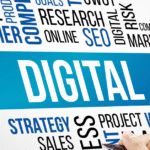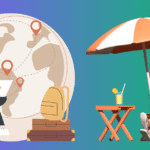The creator economy – the ecosystem of content creators building audiences and monetizing online – has exploded in recent years, reshaping what it means to be an entrepreneur.
No longer is entrepreneurship limited to founding traditional companies; today, an individual with a smartphone, creativity, and personal brand can build a digital entrepreneurship venture from scratch.
The rise of platforms like YouTube, TikTok, Patreon, Substack, Gumroad, Kajabi, and ConvertKit has democratized content creation, allowing anyone to become a creator-entrepreneur. This movement has grown into a global market valued at hundreds of billions of dollars, with over 50 million people worldwide now identifying as content creators.
In this article, we’ll explore how the creator economy is changing entrepreneurship – from new monetization models and the power of personal branding, to real-world success stories, opportunities, and challenges for aspiring creators.
The Rise of the Creator Economy and New Paths to Entrepreneurship
What began as a niche hobby for people uploading videos or blogs has evolved into a professionalized market offering significant opportunities for income generation.
Content creators – whether YouTubers, TikTokers, bloggers, podcasters, or newsletter writers – are now operating as small business owners in their own right. In fact, experts note that “the creator economy is this new era of small businesses” and that successful creators need to think with a business mindset to thrive.
Long gone are the days when being a creator was seen as a casual hobby; today’s top creators often have teams of content strategists, videographers, managers, and advisors supporting them. Many influencers have essentially become full-fledged businesses, sometimes even partnering with agencies or Multi-Channel Networks for operational support and monetization strategy. This professionalization elevates creators into the realm of true entrepreneurs, albeit with a modern twist.
One key difference in the creator-driven model of entrepreneurship is the central role of the personal brand. In the creator economy, the entrepreneur is the brand. A creator’s identity, personality, and values are inseparable from their business venture – their personal branding defines their product.
This contrasts with traditional startups, where the founder is often behind the scenes; here, the founder is front and center. Additionally, in creator businesses, the relationship with the audience is the product itself.
Creators succeed by cultivating loyal communities and trust, turning their follower relationships into tangible value. In other words, a YouTuber or Instagram creator’s content and engagement is their “product,” and their followers are akin to customers who keep returning for that personal connection. Finally, many creators start out driven more by passion than profit; they begin creating content out of intrinsic motivation or creative joy, with monetization coming later. This passion-first approach can make creator-led ventures feel very different from the profit-driven mindset of classical entrepreneurs.
Personal branding has thus become an instrumental asset in this new entrepreneurial landscape. The creator economy has empowered individuals worldwide to share their passions and expertise with global audiences, and at the heart of this movement lies personal branding as the means to stand out in a crowded digital world.
Even in saturated niches, a strong personal brand, essentially, a clear and authentic online identity, helps creators differentiate themselves. Think of how you know to watch a Huda Beauty video for makeup tips or turn to Kayla Itsines for fitness inspiration; each creator’s unique style and story make their brand memorable.
In essence, you are your brand as a creator, and your content, personality, and interaction with your community all become part of a cohesive brand strategy. This direct link between the individual and the business is a hallmark of the creator era of entrepreneurship.
Emerging Monetization Models for Creators
The creator economy is also changing how entrepreneurs make money, introducing new monetization models that differ from traditional businesses.
Rather than a single revenue stream, most creators build multiple income streams around their content. In fact, nearly 90% of creators monetize through multiple revenue streams rather than relying on just one source.
Here are some of the key monetization models for creators that are reshaping entrepreneurial paths:
- Advertising Revenue: Many content creators earn money through ad programs on platforms. For example, YouTube’s Partner Program shares advertising revenue with video creators. YouTube alone paid creators over $30 billion in a recent year through ad revenue and channel memberships. Successful YouTubers can earn substantial income from ads played on their videos. (Across 2021–2023, YouTube paid out more than $70 billion to creators, media companies, and artists on its platform.) However, ad earnings depend on factors like view counts and ad rates, so creators often treat this as just one income source.
- Brand Deals and Sponsorships: Brand partnerships are a major revenue driver in the creator economy. Nearly 80% of creators report that brand deals are their primary income source. Companies pay creators to promote products or produce sponsored content because influencers offer authentic access to niche audiences. This model has grown so much that influencer marketing spend is projected to reach over $20 billion in 2023. From Instagram posts featuring a product to a YouTuber integrating a sponsor’s message in a video, these deals can be very lucrative for creators. The flip side is that creators become somewhat dependent on marketing budgets and brand relationships, leading many to diversify into other monetization methods over time.
- Affiliate Marketing: This is often an entry point for new creator-entrepreneurs. With affiliate marketing, a creator earns a commission by recommending products and linking to them (using special referral links). When followers purchase through those links, the creator gets a cut. Bloggers, YouTubers, and Instagrammers frequently use affiliate programs (like Amazon Associates or niche-specific programs) as a low-friction way to monetize content. It’s common to start with affiliate or a few sponsored posts, but creators often find it’s not enough on its own for the long term – hence the need to expand into owned products or services.
- Fan Memberships and Subscriptions: A hallmark of the new creator economy is the ability to monetize community support directly. Platforms like Patreon, YouTube Memberships, Twitch subscriptions, or Substack for newsletters allow fans to pay a recurring fee to support a creator and access exclusive content. This subscription model provides a more predictable monthly income for creators. Patreon, for instance, has over 250,000 active creators and has paid out more than $3 billion to creators since its founding. Similarly, newsletter platforms like Substack enable writers to earn money from reader subscriptions; the growing popularity of paid newsletters shows that audiences are willing to pay for in-depth, exclusive content from their favorite creators. Membership income can be small at first, but for those who cultivate a dedicated fan base, it becomes a sustainable cornerstone of their business.
- Digital Products and Online Courses: Many creators eventually leverage their expertise to create digital products such as e-books, design templates, or online courses/workshops. Platforms like Gumroad and Kajabi make it easy for creators to sell these products directly to their audience. For example, an illustrator might sell digital art packs on Gumroad, or a business coach might host a paid course on Kajabi. These products can command higher one-time payments and position the creator as an authority (the term “knowledge entrepreneur” is often used for those selling courses). Creators often find that after building an audience, packaging their knowledge or creative work into a product is a logical entrepreneurial step. As one creator economy expert noted, rather than endlessly chasing virality, creators can earn more sustainably by launching premium experiences or content behind a paywall that fans are willing to pay for if it provides real value.
- Merchandise and Creator-founded Brands: Turning an audience into customers for physical products has also become common. In fact, 88% of creators have launched their own product or service line, according to a 2025 insights report. This could be branded merchandise (apparel, accessories, etc.) or full-fledged companies inspired by the creator’s niche. We’ve seen beauty vloggers create cosmetics lines, fitness influencers release workout gear and supplements, gamers sell branded apparel, and chefs launch recipe books or food products. These creator-led brands blur the line between influencer and entrepreneur – the creator uses their platform to market a product they truly own. A striking statistic is that about 2 out of 3 consumers have purchased a product or service that was founded by a creator, showing how much trust and influence top creators command. For example, YouTuber Jimmy “MrBeast” Donaldson not only earns from videos (Forbes estimated $85 million in income last year for him) but has also expanded his empire with ventures like a virtual restaurant chain and a snack brand, effectively lending his personal brand to products from burgers to chocolate. His success illustrates how a creator can parlay content fame into multiple entrepreneurial ventures.
- Donations, Tips, and Live Revenue: Many creators also earn through direct fan support in the form of one-time donations or tips. This could be via livestream gifts (e.g., TikTok gifts, YouTube Super Chats, Twitch donations) or platforms like Buy Me a Coffee and Ko-fi. Interestingly, a majority of creators – about 55% – say that direct donations and tips from followers make up a primary revenue source for them. Live streaming has opened additional revenue avenues: audiences can purchase badges, send paid messages, or tip during streams, which not only monetizes but also boosts community engagement. In some markets, live commerce (live streaming integrated with online shopping) is huge – for example, China’s live-stream e-commerce sector generated roughly ¥1.3 trillion (≈$140 billion) in 2023, with influencers driving ~70% of those sales. While live shopping hasn’t reached that scale globally yet, it shows the potential when creators directly interact with fans to sell products.
Multiple income streams are the norm. Savvy creator-entrepreneurs mix and match these monetization models to build a more resilient business. One common path is to start with affiliate marketing or brand deals, then expand into owned channels and products for more stability.
For instance, a creator might begin by doing sponsored posts, but later launch a paid newsletter or a line of merchandise once they have an established audience.
Diversification is key because each revenue stream has its own risks; ad revenue can fluctuate with algorithm changes and advertiser trends, sponsorships can be seasonal, and fan support can depend on economic factors.
By having multiple streams, creators can smooth out their income. In fact, nearly 70% of creators use multiple platforms (YouTube + Instagram + TikTok, etc.) to reach audiences and cross-promote their content, and similarly, most use more than one monetization method.
The creator economy rewards those who can strategically combine revenue sources and adapt, much like a startup might pivot or add new product lines. Creators evolve their monetization mix as they grow.
The Power of Personal Branding in the Creator Economy
In this new entrepreneurial landscape, personal branding isn’t optional; it’s essential. As noted earlier, the creator is the brand, and cultivating a strong personal brand is often the difference between struggling to get noticed and building a devoted following.
Personal branding means deliberately shaping the audience’s perception of who you are and what you stand for as a creator. This encompasses your voice, style, values, and expertise, as conveyed through your content and interactions.
A well-defined personal brand builds trust – and trust is currency in the creator economy. Surveys show that consumers trust recommendations from individual influencers more than traditional advertisements (61% of consumers say they trust influencer recommendations, and influencer content can yield 11 times higher ROI than typical digital marketing).
This trust translates directly into business value: a creator with a loyal, trusting audience will find it easier to monetize through any method, because followers genuinely believe in their content and endorsements.
One reason personal branding is so powerful is that it enables authentic connection and community-building. Successful creators engage with their audience transparently and personably – sharing not just polished content but also pieces of their life story, challenges, and personality.
This authenticity fosters a sense of relationship; followers feel like they know the creator as a person. As one community builder observed, people want to hear your unique story; those personal anecdotes (a career struggle, a life-changing moment) make you more relatable, genuine, and memorable in a sea of content.
In practice, this might mean a finance YouTuber distinguishing themselves by sharing their journey out of debt, or a career coach on LinkedIn talking about being a first-generation professional who overcame adversity. Such personal narratives become part of the brand and help creators carve out a niche where they are seen as more than just a commodity content provider.
Importantly, owning your brand and audience goes hand-in-hand with personal branding. Unlike a conventional business that can be sold or transferred, a creator’s brand is inherently tied to them, so they must protect and nurture it. Part of this is maintaining consistency (so that your YouTube, TikTok, newsletter, etc., all reinforce the same core identity and values).
It’s also about owning the channels where your audience engages. Many experts advise creators to “own the relationship with your audience and stop relying on social platforms for monetization”. This means building direct lines to fans, for example, through an email list (using tools like ConvertKit to manage newsletters and updates) or having your own website/community.
Relying solely on a platform like Instagram or YouTube for your audience exposes a creator to platform risk (algorithm changes or policy shifts could suddenly limit your reach). By contrast, if you have a loyal following on channels you control (email, personal website, etc.), your personal brand is safer and you can monetize more freely (through direct sales, events, or memberships without a middleman).
Owning your brand also implies legal ownership of your content, your name, and maybe trademarking your catchphrases or logos as your business grows.
To strengthen their personal brand, creators often engage in classic brand-building strategies adapted to individuals. This might include having a clear logo or visual style, a consistent content schedule, a mission statement or tagline that resonates, and even signature language (inside jokes or terms fans recognize).
As a Kajabi entrepreneurship guide put it, “as a knowledge entrepreneur, you are your brand… what you share and how you interact with your audience all fit together into a cohesive brand”. The more cohesive and authentic the brand, the more it attracts opportunities.
Creators with strong personal brands often land better sponsorships (because brands know the creator’s persona aligns with their product), build engaged communities that help with word-of-mouth growth, and can even expand beyond content creation, for example, into writing books, public speaking, or launching product lines, all on the back of their personal credibility.
Finally, personal branding contributes to longevity. In the fast-moving digital world, trends come and go, but a creator who has a trusted brand can weather platform shifts and fickle audience tastes. Their audience might follow them from YouTube to a new platform, or stay subscribed for years, because they’re invested in the person, not just a single piece of viral content.
This loyalty is incredibly valuable for long-term entrepreneurship. We’re now seeing top creators becoming “mainstream intellectual property” in their own right – they can launch shows, products, or even entirely new businesses, and their fans will follow.
In summary, personal branding is the moat around a creator’s business. It’s what turns a one-time viewer into a lifelong fan, and it’s why the creator economy has given rise to a new breed of entrepreneurs whose identity is their business.
Platforms and Tools Fueling the Creator Economy
The boom of the creator economy wouldn’t be possible without the digital platforms and tools that enable individuals to create, distribute, and monetize content globally.
Aspiring creator-entrepreneurs today have an arsenal of services at their disposal to build their business. Here are a few of the major platform powerhouses and tools, and how they support creator entrepreneurship:
- YouTube: The Google-owned video platform is often considered the cornerstone of the creator economy. With over 2 billion users, YouTube gives creators immediate access to a global audience and a built-in monetization system (ads, channel memberships, Super Chat, etc.). It has minted countless creator-entrepreneurs – from vloggers and educators to gamers and entertainers. YouTube’s revenue-sharing model has paid out tens of billions of dollars to creators, and top YouTubers have built thriving businesses. For example, YouTuber MrBeast leveraged the platform to not only earn ad revenue but also launch his own product lines and even attract investors, moving from creator to multi-industry entrepreneur. YouTube also supports merchandise shelves and provides analytics tools to help creators treat their channel like a business. The scale and accessibility of YouTube make it an entry point for many digital entrepreneurs.
- TikTok: TikTok’s rise has shown how a platform can catapult unknown individuals to fame practically overnight. Its short-form video format and algorithmic feed have allowed creators (often very young entrepreneurs) to amass millions of followers quickly. TikTok has its own Creator Fund (which has paid out over $300 million to creators so far), though payouts per view are relatively small. As a result, many TikTokers monetize primarily through brand sponsorships, viral product collaborations, or by funneling TikTok fame to other platforms (like launching a YouTube channel or merch line). The platform’s cultural influence is huge – TikTok trends drive music charts, product sales (the “TikTok made me buy it” phenomenon), and even new careers. Creators like Charli D’Amelio turned TikTok stardom into business deals (TV show, product endorsements, even a clothing line). TikTok’s strength is in viral reach and youth audience; it’s a powerful springboard for entrepreneurial creators, though they often must get creative to monetize that large following beyond the app (through cross-platform presence and merchandise).
- Patreon: Patreon is a membership platform that epitomizes the direct-to-fan support model. It enables creators to run a subscription service where fans pay monthly for exclusive perks (bonus content, early access, community access, etc.). This has been transformative, especially for creators whose content doesn’t always fit ad models – like independent musicians, podcasters, visual artists, or writers – allowing them to earn a steady income from their core fans. Patreon reports that creators on the platform have earned billions collectively. Many podcasts, for instance, use Patreon to offer extra episodes to subscribers, and some have turned their Patreon into the main source of their revenue. The platform has effectively made crowdfunding continuous (as opposed to one-off Kickstarter campaigns), which in turn has given rise to a new class of creator-entrepreneurs who are 100% community-funded. The success of Patreon underscores a central shift in the creator economy: fans are willing to directly finance the creators they love, essentially becoming patrons of the arts (hence the name).
- Substack and Newsletter Platforms: Substack, along with alternatives like Ghost or even paid email via ConvertKit, has led a revival of the email newsletter as a business. Writers and journalists, who once could only monetize through media salaries or ads, can now become entrepreneurial journalists by launching their own subscription newsletters. Substack allows creators to charge readers for weekly or monthly newsletters, taking a cut of the revenue. The model has produced high-profile successes – several journalists and experts now reportedly earn six-figure or even seven-figure annual incomes from thousands of paying subscribers on Substack. As one industry report highlighted, subscription-based content platforms like Substack are rising in popularity, offering creators alternative revenue streams while delivering long-form, in-depth content that audiences cravetheprnet.com. The newsletter format also reinforces the idea of owning your audience: an email list is under the creator’s control, not subject to a social network’s algorithm, which is a big advantage for stability.
- Gumroad, Kajabi, and E-Commerce Tools: For creators developing and selling products (digital or physical), platforms like Gumroad and Kajabi provide critical infrastructure. Gumroad lets creators sell digital files easily – from music and videos to software, art, or writings – with minimal setup. It essentially handles payments, file delivery, and even subscriptions or rentals. This has enabled many niche creators (say, a graphic designer selling icon packs, or an indie game developer selling a game directly) to monetize their work without a traditional publisher or storefront. Kajabi, on the other hand, is tailored for selling online courses, coaching services, and membership sites. It gives creators a way to package their knowledge into a polished product (complete with landing pages, checkout, and even marketing automation). These tools have lowered the barrier for creators to become product entrepreneurs – a fitness YouTuber can sell a workout program on Kajabi, or a photographer can sell a tutorial course – all without needing technical e-commerce expertise. Additionally, many creators integrate print-on-demand services for physical merch (shirts, books, prints), which handle production and shipping, again making it simpler to add a merchandise revenue stream.
- ConvertKit and Audience Management: As creators grow, managing the audience relationship becomes as important as creating content. Email marketing tools like ConvertKit are popular in the creator community for building email lists, sending newsletters, and even selling digital products or subscriptions. ConvertKit is creator-focused (founded by a creator) and provides features like tagging and segmentation so creators can tailor communication to their audience’s interests. The mantra here is to “own your audience” – by having direct contact info (emails), you’re not entirely at the mercy of a platform’s algorithm or policy. Many creators use ConvertKit to launch drip email courses, promote new content or products, and ensure their biggest supporters never miss an update. Similarly, community platforms (Discord servers, Slack groups, Circle.so forums, etc.) are used to deepen engagement with fans in a space outside the big social platforms. All these tools help creators turn a following into a sustainable business, reinforcing that being a creator now often means orchestrating a whole tech stack – from YouTube for discovery, Instagram for branding, Patreon for revenue, to ConvertKit for retention, for example.
Each of these platforms and tools plays a role in the broader creator ecosystem. Together, they have lowered costs and barriers for entrepreneurs: no need to buy a factory or storefront, use online platforms; no need for a big advertising budget – social media is your marketing channel; no need for investors, your early revenue can come directly from fans.
This has led to an explosion of micro-entrepreneurs, giving individuals unprecedented control over turning their creative skills into a livelihood. Of course, using these platforms wisely is key; creators must navigate their rules (e.g., YouTube’s algorithms or Patreon’s fee changes) and sometimes juggle several platforms to avoid putting all their eggs in one basket.
Opportunities and Benefits of the Creator Economy
The creator economy offers exciting opportunities that are reshaping entrepreneurship in an inspirational way. For aspiring creators, here are some of the key opportunities and benefits in this new model:
- Low Barriers to Entry: Unlike traditional businesses that might require significant capital, any motivated individual can start creating content with minimal equipment (often just a phone) and access global distribution via the internet. The creator economy has “ushered in a new era of opportunity, empowering individuals worldwide to share their passions… with global audiences”. This democratization means entrepreneurship is no longer reserved for those with investors or traditional gatekeepers; anyone can potentially carve out a niche and build a following.
- Global Reach and Niche Communities: Digital platforms allow creators to reach audiences around the world. Even niche interests can gather a global fanbase large enough to sustain a business. A small-town artist can sell prints to international fans; a tech expert can have newsletter subscribers from dozens of countries. Indeed, about 65% of creators plan to expand into international markets to grow their audience. The creator economy enables micro-niche businesses that wouldn’t have been viable locally but thrive by aggregating fans globally. This global scale is an opportunity to influence and sell beyond geographical constraints.
- Multiple Revenue Streams and Flexibility: As discussed, creators can earn in many ways – ads, sponsorships, products, memberships, etc. This diversification provides flexibility and resilience. Creators can pivot more easily than a traditional business if one income stream dries up. They can launch new products or content formats quickly to adapt to audience demand. In essence, a creator’s business is very agile: they are often a one-person (or small team) startup that can experiment rapidly at low cost. The ability to tap into multiple monetization models also means creators aren’t reliant on one “big break”, they build up income bit by bit from various sources, which is an empowering way to grow a business.
- Direct Audience Relationships: Perhaps one of the most profound opportunities is that creators own the relationship with their end consumers – the fans. There’s no middleman separating feedback or support. This direct connection means creators can build genuine communities and get real-time input from their audience. It also means marketing is often built in; your followers become your advocates if you nurture them. When a creator with a strong community decides to launch a product or ask for support, the response can be immediate and enthusiastic because they’ve established trust and rapport. This direct line to consumers is something even big brands envy, and it’s turning personal brands into powerful platforms.
- Monetizing Passion and Creativity: The creator economy allows people to turn personal passion into a profession, which is deeply fulfilling. Creators often start by doing what they love – whether that’s cooking, comedy, educating, or reviewing gadgets – and find an audience who values it. Being able to monetize your passion can make the work feel meaningful; creators have the chance to get paid for being themselves and sharing their interests. Over 60% of creators have managed to turn their passion into full-time careers, showing how this model can lead to a genuine livelihood doing what one loves. This opportunity for creative freedom and independence is a huge draw; it’s inspiring many to pursue digital entrepreneurship over a 9-to-5 job.
- Personal Growth and Brand Extensions: Successful creators often find opportunities to extend their brand beyond their initial content platform. A strong personal brand can lead to book deals, speaking engagements, brand ambassadorships, or collaborations that elevate the creator to new arenas. We’ve seen YouTubers branch into traditional media (TV shows, music careers) and influencers create their own product lines or even companies. Creators are becoming, as one report put it, “the new media moguls”, launching production companies, turning their content IP into shows, and rivaling traditional entertainment in influence. The sky is the limit: once you have an audience and a brand, new entrepreneurial ventures (from merchandise to tech startups) become possible in a way that wasn’t before for an individual. Creators today are not just content makers, but increasingly multi-hyphenate entrepreneurs, investors, and brand builders.
In short, the creator economy has unlocked a more accessible, flexible, and passion-driven form of entrepreneurship. It’s inspirational to see a solo creator grow into a business owner reaching millions, and it’s happening across industries, from education to entertainment to e-commerce.
However, this new path also comes with its share of challenges and risks, which creators must navigate to build sustainable careers.
Challenges and Risks in the Creator Economy
While the opportunities are real, it’s important to take an analytical look at the challenges that creators face. Building a business in the creator economy comes with unique risks that are crucial to understand:
- Platform Dependency: Creator-entrepreneurs often rely on third-party platforms (YouTube, Instagram, TikTok, etc.) to reach their audience and earn income. This introduces a dependency on platform algorithms and policies that are outside the creator’s control. A change in a platform’s algorithm can dramatically reduce a creator’s visibility overnight – something many YouTubers and Instagram influencers have experienced. As a result, creators face the risk of “building a business on rented land.” There is also the threat of demonetization or account suspension if a platform decides content violates guidelines, which can cut off revenue suddenly. The advice from experienced creators is to mitigate this risk by owning your audience relationship (e.g., via email lists, personal websites) so you’re not solely reliant on any one platform. Still, the reality is that much of a creator’s fate can be tied to decisions by big tech companies. This platform risk is a new kind of challenge traditional entrepreneurs didn’t face – imagine if a small business had to worry that the mall owner might randomly rearrange all the stores or close its storefront without warning. That’s the equivalent of an algorithm update on social media. Being aware of this and diversifying platforms (as 70% of creators do) is essential.
- Burnout and Pressure to Constantly Create: The creator economy can be a 24/7 hustle. The need to consistently produce content to stay relevant and keep algorithms happy leads many creators to experience burnout. Unlike a traditional job with off-hours, the internet never sleeps – there’s always a pressure to post the next video, respond to comments, stay on top of trends, and maintain a presence. A survey found the average successful creator’s career lasts around 4-5 years, which hints that many burn out or pivot after a relatively short run. Creators often report stress from the continuous content treadmill and the mental toll of public visibility. As Edeling and Wies (2024) noted in their study, the “looming threat of burnout” is a serious issue, and creators have to learn to cope by setting boundaries and taking breaks. However, stepping away for a hiatus carries the fear of losing audience engagement, creating a tough balancing act. In response, there’s a growing conversation about creator mental health. Some platforms and brands are starting to emphasize well-being (for example, some talent agencies encourage their creators to take digital detoxes or share content load with a team). But ultimately, managing burnout is a personal challenge each creator-entrepreneur must navigate to have a sustainable career.
- Income Instability and Inequality: While the creator economy can be lucrative for a few, it is highly unequal and unpredictable for the majority. Earnings can fluctuate month to month based on seasonal advertising trends, the performance of content, or one-off opportunities. Many creators start with very modest income – one report put the average creator’s earnings at only about $285 per month from online content. Only about 40% of creators earn more than $10,000 a year, meaning the majority are not making a full-time living. A small top tier of creators captures the lion’s share of revenue; for example, the top 1% of YouTube channels generate over 80% of the platform’s total ad revenue. This power-law distribution means it’s a hits business: a few “superstar” creators make millions (some like MrBeast reportedly approaching billionaire status), while a huge number struggle to break even. For the aspiring creator, this translates to income instability – a viral month can be followed by a lean month. Unlike a salaried job, there’s no guaranteed paycheck. This risk necessitates financial planning and often diversifying income (as discussed earlier). Some creators mitigate instability by creating subscription income (more predictable) or by maintaining a part-time job until their creator business is reliably profitable. The uneven income also raises a societal question: as millions pursue creator careers, how many can realistically succeed? It underscores that while the creator economy lowers entry barriers, it doesn’t guarantee easy success – competition is intense, and standing out is hard.
- Algorithm and Market Changes: Related to platform dependency, creators are also vulnerable to shifts in the market and technology trends. A format that’s popular today (say, short dance videos) might fall out of favor next year. Platforms like TikTok rose and could theoretically fall due to regulations or user fickleness. Additionally, changes in how brands allocate marketing budgets (e.g., if influencer marketing budgets tighten during a recession) can directly hit creators who rely on sponsorships. We’ve also seen situations like the “Adpocalypse” on YouTube, where changes in advertiser sentiment caused many videos to be demonetized, shocking creators’ incomes. Creators must constantly adapt to stay relevant – learning new platform features (e.g., the rise of YouTube Shorts to compete with TikTok), adjusting content strategies when algorithms prioritize different metrics (like watch time vs. clicks), and even pivoting platforms if needed. This need for agility is a risk in the sense that a creator’s business model is never static; it’s always subject to external changes. It can be exhausting and requires an entrepreneur’s mindset of continuous innovation and learning.
- Social Risks and Personal Toll: Being a creator-entrepreneur means putting your personal self out there, which can invite public scrutiny, trolling, or privacy issues. Negative comments, cancel culture, or controversies can impact a creator’s mental health and business. Unlike a traditional entrepreneur who might operate behind a company brand, a creator’s personal life can become entangled with their work. This means reputational risks are very personal. One misstep on social media can lead to losing followers or sponsors. Additionally, the pressure to maintain a highlight-reel life for the audience can be stressful. While not a financial risk per se, these social and psychological risks are part of the package of creator entrepreneurship and need to be managed through support systems, authenticity (not feeling you have to be “perfect”), and sometimes professional help or PR skills when navigating public issues.
Despite these challenges, many creators are finding ways to thrive. They treat their content creation as a serious business venture – budgeting, strategizing, and investing in growth just like any startup founder would.
We are also seeing the ecosystem mature to offer more support: for instance, creator funds, incubators, and even venture investments are emerging to help creators scale their operations. Some creators now secure investors or join new platforms that offer revenue guarantees, which might stabilize incomes.
There’s also a push for educating creators in business skills, so they can handle taxes, contracts, and scaling beyond just making content. In a way, the current challenges of the creator economy are driving innovation in how we support independent entrepreneurs.
Conclusion: The Evolving Face of Entrepreneurship
The creator economy is undeniably changing the face of entrepreneurship. It has broadened who can be an entrepreneur, what an “entrepreneurial product” can be (a YouTube channel, a personal brand, a digital course), and how businesses grow in the digital age.
Creators are now visionary founders of their own micro-enterprises, personal brand strategists, and community builders all at once. They are turning their content into commerce and their influence into innovation. As creator-led businesses level the playing field, even traditional brands are taking notice and partnering in deeper ways, recognizing creators as the new power players of commerce.
For aspiring creators, the landscape is rich with opportunity – you can build something with global impact from your bedroom. But success in the creator economy requires balancing inspiration with perspiration. It’s about being creative and analytical at the same time: producing content that resonates and also strategizing like a startup CEO.
Personal branding, community engagement, and diversified monetization are the pillars of this new entrepreneurship. And underlying it all is a passion for the craft, as many creators exemplify, love for the work often comes before the profits, yet with persistence and smart strategy, the profits can follow.
The journey isn’t easy or guaranteed. There will be algorithm changes to weather, burnout to guard against, and countless hours of unpaid work in the beginning.
But the stories of creators who have built careers doing what they love – teachers who turned educational YouTube channels into full businesses, gamers who make a living streaming, writers who earn six figures from newsletters, all illustrate a powerful shift.
Entrepreneurship in the digital era can be deeply personal, creator-driven, and community-supported. The creator economy has shown that “content creation [is] being a business, being a venture, and opening up monetization opportunities” in ways we’re only beginning to fully understand.
In this balanced new world, success will favor those who combine authentic creativity with entrepreneurial savvy. Build your personal brand, know your audience, diversify your income, and take care of your well-being like the valuable business asset that it is.
The creator economy is still young and evolving, but one thing is clear: it has already changed what it means to be an entrepreneur, and its influence on the future of work and business will only continue to grow.
Whether you’re an aspiring YouTuber, a freelance writer, or a small business owner looking to leverage content, embracing the creator economy mindset, part inspirational, part analytical, could be your key to thriving in the new age of digital entrepreneurship.
- Remote Startups: How to Lead a Global Team Successfully - 27 September 2025
- How the Creator Economy Is Changing Entrepreneurship - 27 September 2025
- Starting a Business While Traveling: Digital-First Models That Work - 27 September 2025











